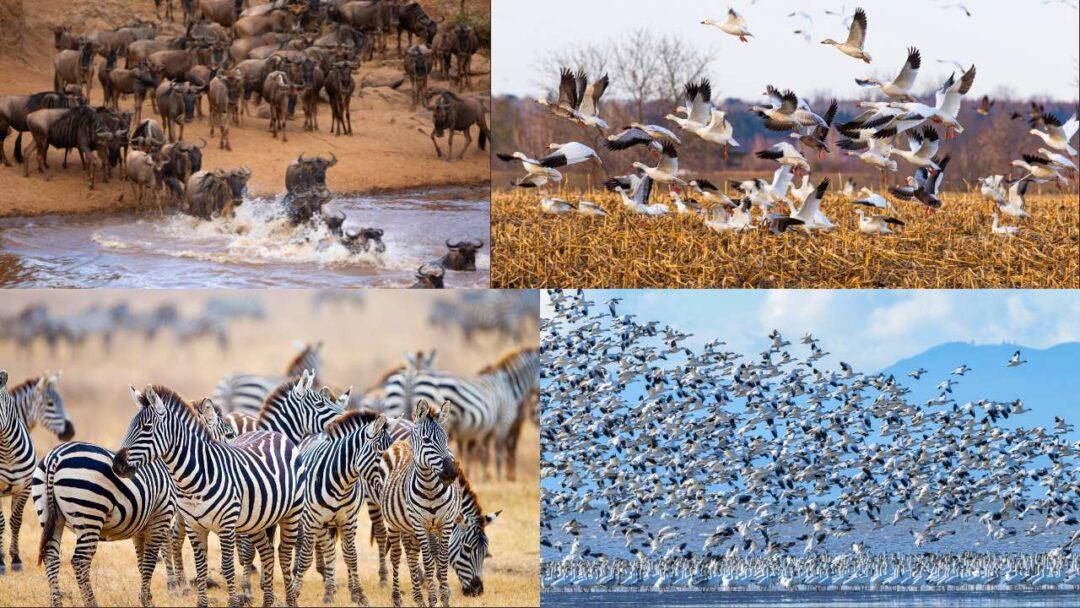Table of Contents

Introduction
The Magic of Migration: Incredible Journeys of Animals. One of nature’s most amazing spectacles is animal migration, the seasonal movement of animals from one region to another. It includes remarkable feats of endurance, navigation, and adaptation that have long captivated scientists and nature enthusiasts. This article delves into the fascinating world of animal migration, emphasizing its environmental importance and shedding light on the incredible journeys undertaken by various species.
I. What is Migration?
- Definition: Migration is the regular, long-distance movement of animals between their breeding and non-breeding grounds.
- Different types of migration: Partial migration, altitudinal migration, and complete migration.
II. Astonishing Animal Migrations:
A. Monarch Butterflies:
- The epic journey: Monarchs travel up to 3,000 miles from Canada and the United States to Mexico, defying generations and returning to the same overwintering sites.
- Remarkable navigation: Monarchs use a combination of sun compass orientation, genetic programming, and environmental cues to navigate accurately.
B. Wildebeest Migration:
- The Great Migration: Over 1.5 million wildebeests, accompanied by zebras and gazelles, traverse the Serengeti ecosystem in Tanzania and Kenya in search of fresh grazing lands.
- Perils of the journey: Crossing crocodile-infested rivers and facing predators such as lions and hyenas.
C. Arctic Terns:
- The ultimate avian traveler: Arctic terns embark on a round-trip migration of approximately 44,000 miles, flying from the Arctic to Antarctica and back.
- Longevity and endurance: Some terns can live up to 30 years, allowing them to complete multiple migrations in their lifetime.
D. Humpback Whales:
- Oceans apart: Humpback whales undertake extensive migrations, swimming thousands of miles between their feeding grounds in polar regions and their breeding grounds in warmer waters.
- Breaching behavior: Humpbacks exhibit spectacular breaching behaviors, leaping out of the water and slapping their fins, perhaps for communication or navigation purposes.
III. The Importance of Migration:
- Genetic diversity: Migration allows for the mixing of genes between different populations, ensuring the survival and adaptability of species.
- Pollination and seed dispersal: Migratory birds and insects contribute to pollination and seed dispersal, crucial for maintaining diverse ecosystems.
- Trophic cascades: Animal migrations can trigger trophic cascades, influencing the population dynamics of other species in the ecosystem.
IV. Threats and Conservation:
- Habitat loss: Destruction of key habitats disrupts migration routes and negatively impacts the survival of migratory species.
- Climate change: Altered weather patterns and ecological cues can interfere with the timing and success of migration.
- Conservation efforts: Protecting critical habitats, implementing wildlife corridors, and raising awareness are vital for safeguarding migratory species.
Why do animals migrate?
Animals migrate for a variety of reasons, including better food sources, breeding grounds, or warmer climates. Animals can increase their chances of survival and reproductive success by moving to different locations.
Which animals are known for their long-distance migrations?
Several animals are well-known for their incredible long-distance migrations. The Arctic tern, monarch butterfly, humpback whale, wildebeest, and Pacific salmon are just a few examples.
How do animals navigate during migration?
During migration, animals use a variety of navigation strategies, including celestial cues, landmarks, the Earth’s magnetic field, and even their sense of smell. These abilities, combined with innate instincts, assist them in locating their destination.
How far can animals migrate?
The distance that animals migrate varies greatly depending on the species. The Arctic tern, for example, has the longest migration, covering approximately 44,000 miles (71,000 kilometers) round trip from its breeding grounds in the Arctic to its wintering grounds in Antarctica.
Do all members of a species migrate?
Not all members of a species migrate. Birds, for example, may exhibit partial migration, in which only certain populations or individuals migrate while others remain in their breeding or wintering areas throughout the year.
How do animals prepare for migration?
Animals prepare for migration by undergoing physical changes such as fat storage for energy, flight muscle strengthening, and reproductive cycle adjustments. They also observe environmental cues to determine the best time to begin their journey.
Are there risks associated with migration?
Yes, migration poses a number of risks and challenges for animals. Predation, exhaustion, adverse weather conditions, habitat loss, and human interference are examples of these. Migration, on the other hand, provides significant benefits that outweigh the risks for many species.
Can humans witness animal migrations?
Yes, humans can see animal migrations in some cases. Several locations around the world are known for hosting spectacular migrations, such as Africa’s Great Wildebeest Migration or North America’s annual monarch butterfly migration.
How can we help protect migrating animals?
Protecting habitats, preserving critical stopover sites, reducing pollution, and raising conservation awareness are all critical steps in ensuring the safety of migrating animals. It is also critical to support wildlife conservation organizations and advocate for responsible land and water management practices.
Conclusion
The magic of migration highlights animals’ incredible abilities and their critical role in maintaining the balance of Earth’s ecosystems. From butterflies crossing continents to whales navigating vast oceans, these extraordinary journeys represent the natural world’s resilience and adaptability. As stewards of the planet, we must strive to comprehend, appreciate, and protect these incredible migrations in order to ensure the continued coexistence of animals and humans.
Nurturing Mental Well-being through Nature’s Surprising Power : NEXT POST